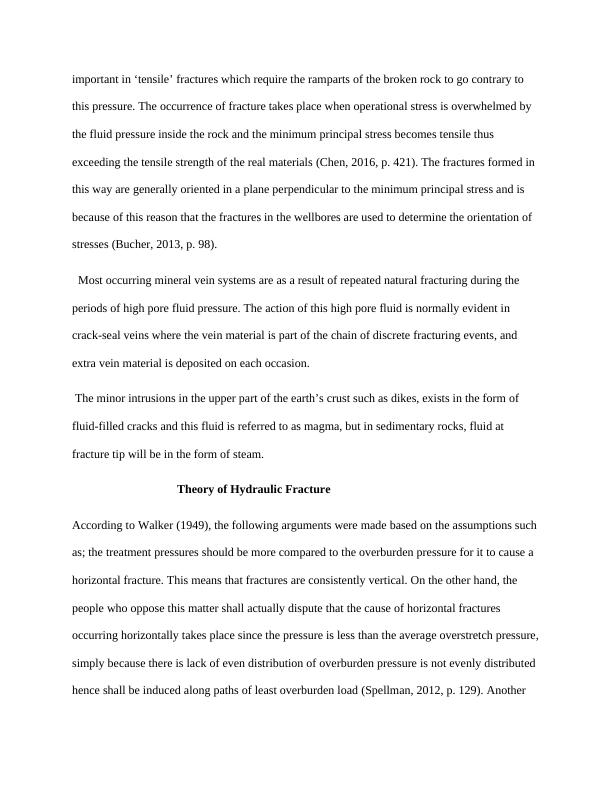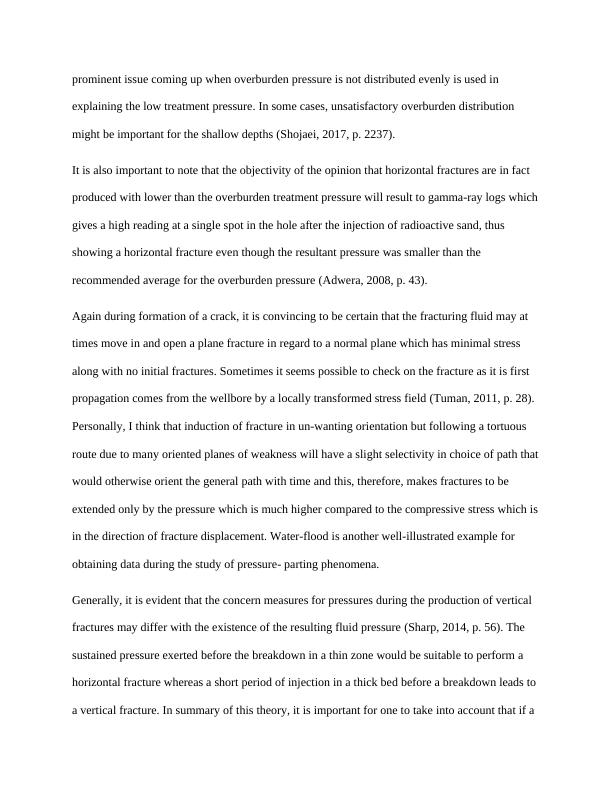Hydraulic Fracturing: Controversial Technique for Oil and Gas Extraction
Added on 2023-06-10
15 Pages3969 Words207 Views
A RESEARCH PAPER ON HYDRAULIC FRACTURING BY:
Name of the Student
Name of the Professor
City/State
Date/Month/Year
Name of the Student
Name of the Professor
City/State
Date/Month/Year

OVERVIEW OF HYDRAULIC FRACTURE
Hydraulic fracturing is also known as hydro-fracturing or hydro-fracking. It refers to a well
modified and a stimulated technique whereby a rock is broken down using liquid under high
pressure (Bernabe, 2009, p. 78). This mechanism includes exertion of great pressure by the
pressurized fluid which can either be water , sand or in some cases a proppant suspended by a
thick agent inside a wellbore to assist in creating point which are weak during the formation of
deep rock through which free flow will be noticed in brine, natural gas, petroleum (Fink, 2013, p.
346). On the other hand, the removal of the good pressure, the hydraulic fracturing small grains
proppants, that is, the fracture is held open by either the sand or aluminum oxide holds (Gleeson,
2016, p. 452).
The hydraulic fracturing system is regarded as most of the controversial techniques in most
countries where its proponent's advocates for the economic remunerations of expansively
reachable hydrocarbons (Wu, 2018, p. 164). Some opposing powers argue that these measures
are overshadowed by prospective environmental impacts which range from the surface or
underground water contamination, noise pollution to public health-related consequential hazards
(Wu, 2018, p. 64). Another related problem of this process is the leakage of the methane gas to
the humanitarian environment and this was discovered in Pennsylvania, that is in the United
States by the Environmental Defense Fund's report. There was also an increase in the seismic
action due to hydraulic fracturing through the inactive faults that resulted due to deep- injection
disposal of the fracturing flow-backs leading to the formation of end products for both fractured
and non-fractured oil together with gas wells.
The pressure overwhelmed those rocks that fracture at large depth as a result of the weight of
rock layers lying on top and their formation cementation. This overpowering is normally
Hydraulic fracturing is also known as hydro-fracturing or hydro-fracking. It refers to a well
modified and a stimulated technique whereby a rock is broken down using liquid under high
pressure (Bernabe, 2009, p. 78). This mechanism includes exertion of great pressure by the
pressurized fluid which can either be water , sand or in some cases a proppant suspended by a
thick agent inside a wellbore to assist in creating point which are weak during the formation of
deep rock through which free flow will be noticed in brine, natural gas, petroleum (Fink, 2013, p.
346). On the other hand, the removal of the good pressure, the hydraulic fracturing small grains
proppants, that is, the fracture is held open by either the sand or aluminum oxide holds (Gleeson,
2016, p. 452).
The hydraulic fracturing system is regarded as most of the controversial techniques in most
countries where its proponent's advocates for the economic remunerations of expansively
reachable hydrocarbons (Wu, 2018, p. 164). Some opposing powers argue that these measures
are overshadowed by prospective environmental impacts which range from the surface or
underground water contamination, noise pollution to public health-related consequential hazards
(Wu, 2018, p. 64). Another related problem of this process is the leakage of the methane gas to
the humanitarian environment and this was discovered in Pennsylvania, that is in the United
States by the Environmental Defense Fund's report. There was also an increase in the seismic
action due to hydraulic fracturing through the inactive faults that resulted due to deep- injection
disposal of the fracturing flow-backs leading to the formation of end products for both fractured
and non-fractured oil together with gas wells.
The pressure overwhelmed those rocks that fracture at large depth as a result of the weight of
rock layers lying on top and their formation cementation. This overpowering is normally

important in ‘tensile’ fractures which require the ramparts of the broken rock to go contrary to
this pressure. The occurrence of fracture takes place when operational stress is overwhelmed by
the fluid pressure inside the rock and the minimum principal stress becomes tensile thus
exceeding the tensile strength of the real materials (Chen, 2016, p. 421). The fractures formed in
this way are generally oriented in a plane perpendicular to the minimum principal stress and is
because of this reason that the fractures in the wellbores are used to determine the orientation of
stresses (Bucher, 2013, p. 98).
Most occurring mineral vein systems are as a result of repeated natural fracturing during the
periods of high pore fluid pressure. The action of this high pore fluid is normally evident in
crack-seal veins where the vein material is part of the chain of discrete fracturing events, and
extra vein material is deposited on each occasion.
The minor intrusions in the upper part of the earth’s crust such as dikes, exists in the form of
fluid-filled cracks and this fluid is referred to as magma, but in sedimentary rocks, fluid at
fracture tip will be in the form of steam.
Theory of Hydraulic Fracture
According to Walker (1949), the following arguments were made based on the assumptions such
as; the treatment pressures should be more compared to the overburden pressure for it to cause a
horizontal fracture. This means that fractures are consistently vertical. On the other hand, the
people who oppose this matter shall actually dispute that the cause of horizontal fractures
occurring horizontally takes place since the pressure is less than the average overstretch pressure,
simply because there is lack of even distribution of overburden pressure is not evenly distributed
hence shall be induced along paths of least overburden load (Spellman, 2012, p. 129). Another
this pressure. The occurrence of fracture takes place when operational stress is overwhelmed by
the fluid pressure inside the rock and the minimum principal stress becomes tensile thus
exceeding the tensile strength of the real materials (Chen, 2016, p. 421). The fractures formed in
this way are generally oriented in a plane perpendicular to the minimum principal stress and is
because of this reason that the fractures in the wellbores are used to determine the orientation of
stresses (Bucher, 2013, p. 98).
Most occurring mineral vein systems are as a result of repeated natural fracturing during the
periods of high pore fluid pressure. The action of this high pore fluid is normally evident in
crack-seal veins where the vein material is part of the chain of discrete fracturing events, and
extra vein material is deposited on each occasion.
The minor intrusions in the upper part of the earth’s crust such as dikes, exists in the form of
fluid-filled cracks and this fluid is referred to as magma, but in sedimentary rocks, fluid at
fracture tip will be in the form of steam.
Theory of Hydraulic Fracture
According to Walker (1949), the following arguments were made based on the assumptions such
as; the treatment pressures should be more compared to the overburden pressure for it to cause a
horizontal fracture. This means that fractures are consistently vertical. On the other hand, the
people who oppose this matter shall actually dispute that the cause of horizontal fractures
occurring horizontally takes place since the pressure is less than the average overstretch pressure,
simply because there is lack of even distribution of overburden pressure is not evenly distributed
hence shall be induced along paths of least overburden load (Spellman, 2012, p. 129). Another

prominent issue coming up when overburden pressure is not distributed evenly is used in
explaining the low treatment pressure. In some cases, unsatisfactory overburden distribution
might be important for the shallow depths (Shojaei, 2017, p. 2237).
It is also important to note that the objectivity of the opinion that horizontal fractures are in fact
produced with lower than the overburden treatment pressure will result to gamma-ray logs which
gives a high reading at a single spot in the hole after the injection of radioactive sand, thus
showing a horizontal fracture even though the resultant pressure was smaller than the
recommended average for the overburden pressure (Adwera, 2008, p. 43).
Again during formation of a crack, it is convincing to be certain that the fracturing fluid may at
times move in and open a plane fracture in regard to a normal plane which has minimal stress
along with no initial fractures. Sometimes it seems possible to check on the fracture as it is first
propagation comes from the wellbore by a locally transformed stress field (Tuman, 2011, p. 28).
Personally, I think that induction of fracture in un-wanting orientation but following a tortuous
route due to many oriented planes of weakness will have a slight selectivity in choice of path that
would otherwise orient the general path with time and this, therefore, makes fractures to be
extended only by the pressure which is much higher compared to the compressive stress which is
in the direction of fracture displacement. Water-flood is another well-illustrated example for
obtaining data during the study of pressure- parting phenomena.
Generally, it is evident that the concern measures for pressures during the production of vertical
fractures may differ with the existence of the resulting fluid pressure (Sharp, 2014, p. 56). The
sustained pressure exerted before the breakdown in a thin zone would be suitable to perform a
horizontal fracture whereas a short period of injection in a thick bed before a breakdown leads to
a vertical fracture. In summary of this theory, it is important for one to take into account that if a
explaining the low treatment pressure. In some cases, unsatisfactory overburden distribution
might be important for the shallow depths (Shojaei, 2017, p. 2237).
It is also important to note that the objectivity of the opinion that horizontal fractures are in fact
produced with lower than the overburden treatment pressure will result to gamma-ray logs which
gives a high reading at a single spot in the hole after the injection of radioactive sand, thus
showing a horizontal fracture even though the resultant pressure was smaller than the
recommended average for the overburden pressure (Adwera, 2008, p. 43).
Again during formation of a crack, it is convincing to be certain that the fracturing fluid may at
times move in and open a plane fracture in regard to a normal plane which has minimal stress
along with no initial fractures. Sometimes it seems possible to check on the fracture as it is first
propagation comes from the wellbore by a locally transformed stress field (Tuman, 2011, p. 28).
Personally, I think that induction of fracture in un-wanting orientation but following a tortuous
route due to many oriented planes of weakness will have a slight selectivity in choice of path that
would otherwise orient the general path with time and this, therefore, makes fractures to be
extended only by the pressure which is much higher compared to the compressive stress which is
in the direction of fracture displacement. Water-flood is another well-illustrated example for
obtaining data during the study of pressure- parting phenomena.
Generally, it is evident that the concern measures for pressures during the production of vertical
fractures may differ with the existence of the resulting fluid pressure (Sharp, 2014, p. 56). The
sustained pressure exerted before the breakdown in a thin zone would be suitable to perform a
horizontal fracture whereas a short period of injection in a thick bed before a breakdown leads to
a vertical fracture. In summary of this theory, it is important for one to take into account that if a

End of preview
Want to access all the pages? Upload your documents or become a member.